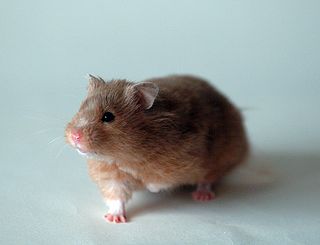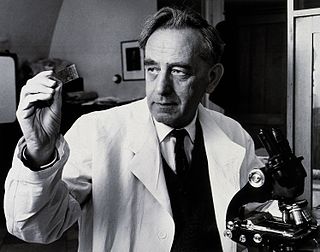
Hamsters are rodents belonging to the subfamily Cricetinae, which contains 19 species classified in seven genera. They have become established as popular small pets. The best-known species of hamster is the golden or Syrian hamster, which is the type most commonly kept as a pet. Other hamster species commonly kept as pets are the three species of dwarf hamster, Campbell's dwarf hamster, the winter white dwarf hamster and the Roborovski hamster.

The golden hamster or Syrian hamster is a rodent belonging to the hamster subfamily, Cricetinae. Their natural geographical range is in an arid region of northern Syria and southern Turkey. Their numbers have been declining in the wild due to a loss of habitat from agriculture and deliberate elimination by humans. Thus, wild golden hamsters are now considered endangered by the International Union for Conservation of Nature. However, captive breeding programs are well established, and captive-bred golden hamsters are often kept as small house pets. They are also used as scientific research animals.

George Robert Waterhouse was an English naturalist. He was a keeper at the department of geology and later curator of the Zoological Society of London's museum.

Israel Aharoni was a zoologist in Ottoman and British Palestine widely known as the "first Hebrew zoologist."

The Turkish hamster, also referred to as Brandt's hamster, Azerbaijani hamster, or avurtlak, is a species of hamster native to Turkey, Azerbaijan and other surrounding nations. The Turkish hamster, first catalogued in 1878, is a fairly close relative of the Syrian or golden hamster, though far less is known about it, and it is rarely kept as a pet. The population of the Turkish hamster is said to be declining in the wild, yet this hamster is often used in laboratory testing. Turkish hamsters have lifespans of about two years and are solitary, nocturnal animals, which practice hibernation. They are reported to be more aggressive than other members of the family Cricetidae. They are tan and dark, sandy brown in color. Like all hamsters, the Turkish hamster has cheek pouches that allow it to carry large amounts of food at one time.

Phodopus, a genus of rodents in the hamster subfamily Cricetinae—a division of the larger family Cricetidae—is a lineage of small hamsters native to central Asia that display unusual adaptations to extreme temperatures. They are the only known hamsters that live in groups and, in some cases, rely on significant contributions by males to the raising of offspring. They are nocturnal and active throughout the year; they do not hibernate. Species of Phodopus, together with members of the genera Cricetulus, Allocricetulus and Tscherskia are called dwarf hamsters because of their small size relative to other hamsters.

A hamster wheel or running wheel is an exercise device used primarily by hamsters and other rodents, but also by other cursorial animals when given the opportunity. Most of these devices consist of a runged or ridged wheel held on a stand by a single or pair of stub axles. Hamster wheels allow rodents to run even when their space is confined. The earliest dated use of the term "hamster wheel", located by the Oxford English Dictionary, is in a 1949 newspaper advertisement. Squirrel cages featured in an 1885 catalog titled Catalogue of the Osborn M’F’G Co. came with running wheels for the squirrels, just like a hamster cage.

The European hamster, also known as the Eurasian hamster, black-bellied hamster or common hamster, is the only species of hamster in the genus Cricetus. It is native to grassland and similar habitats in a large part of Eurasia, extending from Belgium to the Altai Mountains and Yenisey River in Russia. Historically, it was considered a farmland pest and had been trapped for its fur. Its population has declined drastically in recent years and is now considered critically endangered. The main threats to the species are thought to be intensive agriculture, habitat destruction, and persecution by farmers.
The Golden Hamster Saga is a children's book series written by German author Dietlof Reiche, and translated by John Brownjohn. It was illustrated by Joe Cepeda. The series revolves around a golden hamster named Freddy Auratus, two silly guinea pigs named Enrico and Caruso, a black, civilized tomcat named Sir William, and Freddy's owner, Mr. John, who translates German to English.

Saul Adler OBE FRS was an Israeli expert on parasitology.

The Romanian hamster or Dobrudja hamster is a species of rodent in the family Cricetidae. It is found in Bulgaria and Romania. The scientific name honors the British ornithologist Alfred Newton, who had published a short description and an illustration of this species in 1870 without knowing it to be a valid species.
Ascocotyle pindoramensis is a fluke in the genus Ascocotyle that occurs along the eastern coast of the Americas from Brazil to Nicaragua, Mexico, Louisiana, and Florida and doubtfully in Egypt. It occurs in the intestine of its definitive hosts. Hosts recorded in the wild include the least bittern, roseate spoonbill, great blue heron, striated heron, stripe-backed bittern, yellow-crowned night heron, black-crowned night heron, osprey, Neotropic cormorant, and marsh rice rat. In the marsh rice rat, it infected 9% of rats examined in a 1970–1972 study in the salt marsh at Cedar Key, Florida, but none in a freshwater marsh. A. pindoramensis has been experimentally introduced into the domestic duck, chicken, dog, house mouse, and golden hamster. It occurs in various body parts of its intermediate hosts—the poeciliid fish Phalloptychus januarius, Poecilia catemaconis, Poecilia mexicana, Poecilia mollienisicola, Poecilia vivipara, and a species of Xiphophorus and the cichlid Tilapia. It was first described as Pygidiopsis pindoramensis in 1928 and subsequently as Pseudoascocotyle mollienisicola in 1960. The latter species was moved to Ascocotyle in 1963, but only in 2006 it was recognized that the two represent the same species, which is now known as Ascocotyle pindoramensis. Other flukes from Argentina and Mexico that were identified as Pygidiopsis pindoramensis instead represent a different species of Pygidiopsis.
Hilda Margaret Bruce was a British zoologist, best known for her discovery of the Bruce effect, a pheromonal behaviour observed in many rodent species. Her work on the control of fertility earned her the Oliver Bird Medal.

A hamster cage is an enclosure designed to house one hamster. It is recommended that hamster cages are at least 5000cm² for dwarf hamster except Roborovski and 6000cm² for syrian and Roborovski, although there is evidence that hamsters experience less stress if housed in larger cages. Commercially available pens are made of wire or plastic - both of which are unsafe for hamsters. Some pet owners house their hamsters in aquarium tanks, and some make their own pens out of wood or safe materials like plexi. Laboratory hamsters, commonly known as laboratory Syrian hamsters, are housed in pens designed for scientific use. There are also special pens designed for hamster shows.

The Natural History of Aleppo is a 1756 book by naturalist Alexander Russell on the natural history of Aleppo. In 1794 his half-brother, Patrick Russell, revised and expanded the text in a second edition. The book is significant for its quality, the contemporary interest it attracted, and for being a product of the Scottish Enlightenment.
Syrian hamster behavior refers to the ethology of the Syrian hamster.

Gulf Hamstery was a hamstery which established the commercial Syrian hamster industry in the United States. It operated between 1946 through the early 1950s and was located in Mobile, Alabama.
Syrian hamsters are one of several rodents used in animal testing. Syrian hamsters are used to model human medical conditions including various cancers, metabolic diseases, non-cancer respiratory diseases, cardiovascular diseases, infectious diseases, and general health concerns. In 2014, Syrian hamsters accounted for 14.6% of the total animal research participants in the United States covered by the Animal Welfare Act.
Hamster polyomavirus is an unenveloped double-stranded DNA virus of the polyomavirus family whose natural host is the hamster. It was originally described in 1967 by Arnold Graffi as a cause of epithelioma in Syrian hamsters.
Manuel Álvarez-Uría Rico-Villademoros is a Spanish cell biologist who held the presidency of the Royal Academy of Medicine of the Principality of Asturias (Spain) for more than a decade until 2015. He has received some of the highest medical research prizes awarded in Spain. He was born in Oviedo, on July 1, 1943.


















